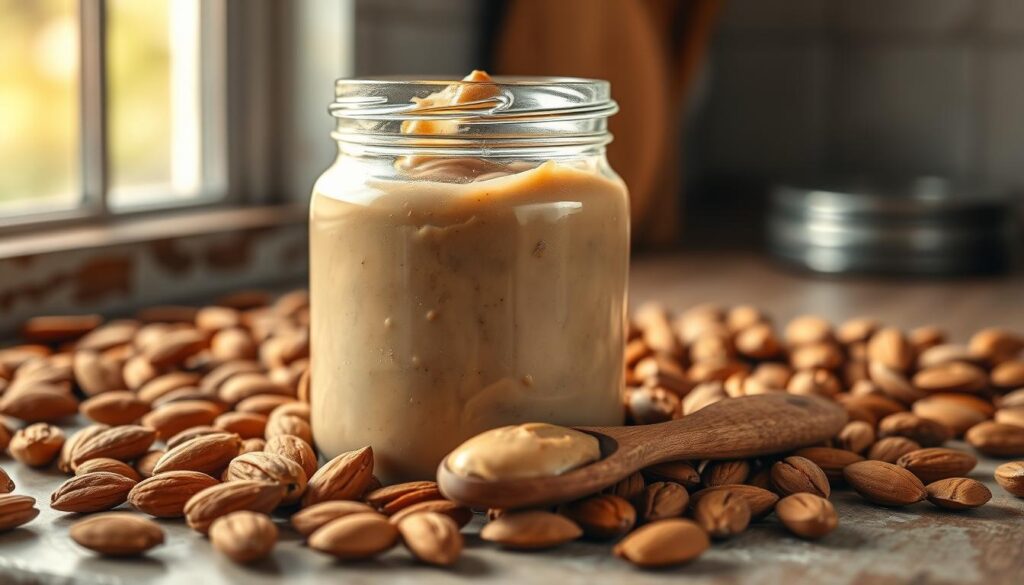As a busy parent, I’m always on the lookout for quick, healthy snacks for my family. Almond butter is a favorite, but it can be pricey. So, I learned to make my own. It’s easy and saves money.
Table of Contents
Introduction to Homemade Almond Butter
Homemade almond butter is a treat that beats store-bought versions. It offers a thick, creamy, and freshly roasted taste that’s hard to find elsewhere. Plus, making it yourself saves money and lets you pick the ingredients and flavor.
Why Make Your Own Almond Butter?
There are many advantages of homemade almond butter over store-bought. Store-bought almond butters often have added oils, sugars, and preservatives. These can hide the natural taste of almonds. Making your own almond butter lets you enjoy the full nutritional benefits without any extra additives.
Advantages of Homemade Almond Butter
- Superior taste and texture compared to store-bought options
- Ability to control the ingredients and customize the flavor
- More affordable than commercial almond butter brands
- Greater nutritional value from the pure, natural ingredients
The steps to make almond butter at home are simple and can be adjusted to your taste. With just a few easy steps, you can enjoy the benefits of making almond butter and relish the homemade taste.
“Homemade almond butter is ultra thick, creamy, and tastes like warm, freshly roasted almonds. It’s far superior to store-bought options, which often contain added oils, sugars, and preservatives.”

Ingredients Needed for Almond Butter
To make delicious homemade almond butter, you’ll need raw, unsalted almonds. The recipe requires 3 cups of raw almonds to make about 16 ounces of smooth almond butter. You can also add a pinch of sea salt for extra flavor. Optional ingredients like honey, cinnamon, vanilla extract, or coconut oil can help create unique tastes.
Making almond butter at home is easy and cheaper than buying it. Roasting the almonds at 350°F for 15 minutes brings out their oils and nutty smell. After they cool, blend them in a food processor or high-powered blender for 15 minutes until smooth.
Homemade almond butter keeps well in an airtight container in the fridge for up to a month. It’s a great condiment to have around. Try mixing in honey & cinnamon, chocolate, pumpkin spice, or chai to make your own special almond butter.

Equipment Recommended for Making Almond Butter
To make tasty homemade almond butter, you’ll need a strong food processor or high-speed blender. Both can do the job well, but there are some differences to think about.
Food Processor vs. Blender
Food processors are top-notch for making almond butter. They have a big bowl that lets the almonds move freely. The blades can grind the nuts into a smooth, creamy paste. A good food processor makes almond butter consistently every time.
A high-speed blender is also a good choice for making almond butter. Blenders come with a tamper tool to help push the almonds into the blades. This makes blending faster. But, make sure your blender has a strong motor to handle the thick almond butter.
| Feature | Food Processor | Blender |
|---|---|---|
| Blade Design | Wide, flat blades for efficient grinding | Narrow, sharp blades for high-speed blending |
| Bowl Size | Larger bowl allows for more even processing | Smaller pitcher may require more manual scraping |
| Tamper Tool | Not typically included | Many high-speed blenders have a tamper tool |
| Motor Power | Powerful motors handle thick nut butters | High-powered motors are essential for blending nuts |
Both food processors and high-speed blenders can make effective almond butter. Your choice might depend on what you like better and what you have at home.
Step-by-Step Instructions for Making Almond Butter
Making your own homemade almond butter is easy and fun. First, heat your oven to 350°F (175°C). Spread 3 cups of raw almonds on a baking sheet. Roast them for 10-12 minutes, stirring halfway, to bring out their flavor and oils.
Roasting the Almonds
After the almonds cool a bit, put them in a food processor or blender. Blend them for 10-15 minutes. Stop to scrape down the sides as needed. This will turn them into smooth, creamy almond butter.
Blending the Roasted Almonds
3 cups of raw almonds make about 2 cups or 16 ounces of homemade almond butter. It takes about 10-12 minutes in a food processor to get the right texture. Making it yourself can save money, costing about $5.50 for 16 ounces with almonds from Costco.
| Metric | Value |
|---|---|
| Almonds Needed | 3 cups (1 lb) |
| Yield | 2 cups (16 oz) almond butter |
| Blending Time | 10-12 minutes |
| Cost | ~$5.50 for 16 oz |
It’s important to pasteurize and handle the almonds right to keep your homemade almond butter safe and good. By following these steps, you can make a tasty and healthy nut butter at home.
Tips and Tricks for Perfect Homemade Almond Butter
Making the perfect homemade almond butter takes patience and focus. Whether you’re new to nut butters or a pro, these tips and tricks will guide you to the creamy, smooth texture you desire.
Remember, patience is key. Turning almonds into butter takes time. Let your blender or food processor do its job. You might need to use a tamper to help. It can take 5 to 8 minutes, depending on your appliance.
Roasting your almonds before blending is crucial. It makes them blend better and adds flavor. Spread raw almonds on a baking sheet and roast at 350°F for 10 minutes, stirring often, until fragrant and golden.
- Use room-temperature almonds for best results. Chilled almonds can make blending harder.
- Add a neutral-flavored oil, like grapeseed or avocado oil, to help with texture.
- Try adding vanilla extract, cinnamon, or honey after blending for extra flavor.
- Keep your almond butter in an airtight container in the fridge for up to two weeks, or freeze for six months.
With these tips and tricks, you’ll make the perfect homemade almond butter. It’s great for recipes or a tasty snack.
How to Make Almond Butter
Making almond butter at home is rewarding. It needs patience and careful attention. The secret to great almond butter is patience and proper roasting.
Patience is Key
Making almond butter is a labor of love. It takes time, from a few minutes to up to 20 minutes. This depends on your blender or food processor’s power. But the wait is worth it for the smooth, creamy butter.
Roasting Enhances Flavor
Roasting almonds in the oven for about 10 minutes is key. It brings out their natural oils and intensifies the flavor. This step makes your homemade almond butter taste better and feel more satisfying.
By patiently roasting the almonds, you get a homemade almond butter that’s better than store-bought. The patience and roasting steps are crucial for making the perfect how to make almond butter at home.
“Homemade almond butter is a delightful treat that’s worth the time and effort to make. The rich, creamy texture and intense flavor are unparalleled.”
Flavor Variations and Add-Ins
Once you’ve learned to make homemade almond butter, the fun starts! Try different flavors to make your own special spreads. You can choose from sweet or savory, and there are many ways to make your almond butter just right.
Sweet and Savory Options
For a sweet twist, add honey, vanilla extract, or cinnamon to your almond butter. Maple syrup can also be blended in for a caramel taste. If you like savory, try sea salt or spices like nutmeg, ginger, or chili powder.
Be creative with nut and seed mix-ins too. Adding peanut butter or cashew butter can be interesting. Chia seeds or ground flaxseeds can also add nutrients.
Homemade almond butter lets you customize it however you like. You can choose smooth or crunchy textures. Try different flavors to find your new favorite nut butter.
Storing and Freezing Homemade Almond Butter
Making your own almond butter lets you control how it’s stored. You can enjoy it for a few weeks or save it for later. There are simple ways to store and freeze your homemade almond butter.
Storing Almond Butter at Room Temperature
Homemade almond butter stays fresh in an airtight container or mason jar for up to 2 weeks. It’s perfect for quick snacks or recipes. Just keep it in a cool, dry spot, away from sunlight.
Refrigerating Almond Butter
For longer storage, refrigerate your almond butter for up to 6 months. The fridge slows down oxidation, keeping the oils fresh. This way, your almond butter stays creamy and flavorful.
Freezing Almond Butter
To keep your almond butter even longer, freeze it for up to 6 months. Put it in an airtight container or freezer-safe bag. Thaw it at room temperature or in the fridge when you’re ready to use it.
Choose the best storage method to keep your homemade almond butter fresh. Store it in a cool, dark place to avoid rancidity. With the right storage, enjoy your homemade almond butter for months.
Nutritional Benefits of Almond Butter
Almond butter is a nutritious spread that offers many health benefits. It’s packed with protein, fiber, healthy fats, and vitamins and minerals. These include vitamin E, magnesium, and potassium. Eating almond butter can help your heart, manage weight, and boost overall health when part of a balanced diet.
One tablespoon (16 grams) of plain almond butter (no salt added) contains:
- Calories: 98
- Fat: 9g
- Sodium: 1mg
- Carbohydrates: 3g
- Fiber: 1.6g
- Sugars: 0.7g
- Protein: 3.4g
- Vitamin E: 3.9mg
- Magnesium: 44.6mg
- Calcium: 55.5mg
- Vitamin B2: 0.2mg
- Iron: 8.5mcg
Almond butter is calorie-dense, with 98 calories per tablespoon. It gets 76% of its calories from fat, 13% from protein, and 11% from carbs. It has about 5 grams of monounsaturated fats per tablespoon, which are good for the heart.
Almond butter is more heart-healthy than peanut butter. It has less saturated fat, more monounsaturated fat, and more fiber. Eating tree nuts, like almond butter, can lower the risk of heart disease, cancer, and other health issues.
Almonds, the main ingredient in almond butter, are rich in calcium and magnesium. These are key for strong bones and muscle and nerve function. The vitamin E in almonds also helps repair damage from oxidative stress. This reduces the risk of obesity, diabetes, and certain cancers.
However, almond butter can be allergenic for people with tree nut allergies. About 0.5% to 1% of the U.S. population has this allergy. Also, almond butter is high in oxalates. This can be a problem for those prone to kidney stones.
Conclusion
Making almond butter at home is easy and rewarding. You only need a few ingredients and a food processor or blender. This way, you can make a delicious, homemade almond butter that’s better than store-bought.
Enjoy your homemade spread on toast, in smoothies, or as a snack. It’s full of good nutrients and you can make it just how you like it.
Almond butter is packed with healthy fats, protein, and fiber. It also has vitamins and minerals. Making it yourself means you avoid additives found in store-bought versions.
It’s also very versatile. You can use it in sweet treats like pancakes or in savory dishes like salad dressings.
If you want to boost your heart health or manage your blood sugar, making almond butter is a great choice. This article will help you make your own tasty almond butter. Start making your own today and enjoy the delicious homemade spread.
Embrace the conclusion of this journey and savor the benefits of homemade almond butter.
